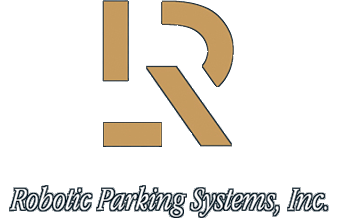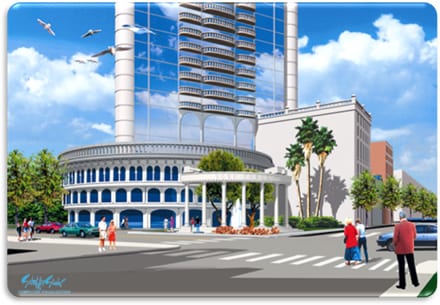Robotic Parking Solutions
Creates Space for Design, Development & Community
More Space, Less Traffic
Cities and development projects that include green space and common areas in which people can interact are more beautiful, livable, safe and desirable to businesses, tourists and residents. However, attracting people to these urban areas means attracting and parking their cars.
Numerous research studies (by MIT, Transportation Alternatives and others) state that 30% to 50% of traffic congestion in city centers is generated by drivers searching for a parking space. A lack of sufficient downtown parking is often due to the large space required for conventional ramp parking.
Architects and developers regularly have to compromise design or reduce saleable space to accommodate required parking. Sometimes, the large amount of land area required for parking makes the entire project nonviable.
Robotic Parking Systems is the Solution
The top of the line RPS 1000 automated parking system can accommodate from 200 to over 5000 parking spaces using half the space of a ramp-style parking garage. Its high-speed efficiency and fast retrieval times guarantee a satisfying user experience. (Take a look at the RPS 100 and RPS 200 for smaller garages.)
By reducing the land area used for parking, the RPS 1000 gives cities opportunities for more green space or to build parking garages in downtown areas previously considered impossible. And, improved parking greatly reduces traffic congestion.
Developers gain more saleable space. Or, the space saved can be used for green space and open areas to help meet LEED standards.
Modular System
The flexible, modular Robotic Parking System can be built above ground, underground, inside a building, on top of a building or under a building. Lot sizes can be as small as 60 ft. x 60 ft., and the height (or depth) can be up to 130 ft. (The ideal footprint is 100 ft. x 200 ft. by 48 ft. — 60 ft. high.)
True Redundancy for Greater Reliability
The RPS 1000 offers true redundancy. This translates into a greater level of reliability and ensures uninterrupted operation.
All major components have at least one backup system and in some cases as many as four. No single failure will ever result in the system being inoperable.
Robotic Parking System’s HMI (Human Machine Interface) is one of the most sophisticated diagnostics systems in the industry. Its patented high level warning systems provide alerts well in advance of any failures to minimize downtime.
Any mechanical or electronic component can fail. However, the beauty of the Robotic Parking Systems is that even in the event of failure, the system continues to operate. Uptime of the system is unprecedented.
Flexible Façades
The façade is completely flexible and can be designed to blend in with neighboring buildings with a look that is contemporary, historic, traditional, etc. Any type of material can be used — concrete, wood, brick, stone, aluminum, etc. It is completely up to the imagination of the owner and his architect.
Safer & More Secure
Robotic Parking Systems virtually eliminate the risk of vehicle damage or theft as well as the risk of personal injury so common in conventional lots and garages. Rather than spending an exorbitant amount of time driving around looking for a parking space, drive up to the garage and enter the ground level entry terminal; get out and lock the car; push a few buttons and simply walk away. When leaving, the driver returns to a well lit lobby where the car is quickly delivered to a ground floor exit terminal. Get in and drive away. Hassle free!
Eco-friendly & Cost Effective
The RPS 1000 is a green parking solution. Electromechanical automatic parking reduces CO2 emissions and other pollutants and greenhouse gases. No cars are run inside the garage so there are no choking car emissions to ventilate. Also, since cars are not circling the block looking for a parking space, there is less pollution and less traffic congestion. Drivers get off the street faster!
Overall development cost can be significantly lower than for a conventional garage. Since there are no people or running cars inside the garage, there are lower lighting and ventilation requirements. Lower insurance costs, lower personnel expenses and smaller land area required and more – all add up to increased savings.
Underground applications are particularly well suited to the RPS 1000. Because only half the space is needed for the same amount of parking as conventional garages, developers can save as much as 50% on the excavation alone.
Enhanced System Design
Typical Design
High-bay, stacker type design where all three movements (in and out, up and down, back and forth down the aisles) are handled by one central unit. In the case of failure, an entire portion of the garage can become inoperable.

The Robotic Parking Systems Patented Design
Enhanced, patented design where all three movements are separated and handled by individual intelligent components with true redundancy. No single failure will ever result in the garage becoming inoperable.

RPS 100
Perfect Solution for Small Sites
Maximizing space is critical for architects and developers particularly on a small site. If too much space is consumed by parking requirements, too little saleable space may be left for the project to be viable. Also, green space and open areas for design or LEED certification may be compromised in order to fit more parking.
Robotic Parking Systems’ RPS 100 automated parking garage is the ideal solution for small sites with a high demand for parking. This automatic parking structure uses only 50% of the land area typically required by a conventional ramp-style parking garage.
The RPS 100’s high-speed efficiency and fast retrieval times ensure rapid throughout (the number of cars in and out per hour) and a satisfying user experience.
Robotic Parking Systems’ RPS 100 can accommodate from 100 to 200 cars. Additional modules can be added adjacent to the facility to expand capacity. (Take a look at the RPS 1000 and RPS 200 for additional configurations.)
This flexible, modular Robotic Parking System can be built above ground, underground, inside a building, on top of a building or under a building. Lot sizes can be as small as 60 ft. x 60 ft. Height (or depth) can be from 25 ft. – 120 ft.

More Green Space — More Parking
Think of the space consumed in urban areas for just parking. The orange areas in this illustration represent typical downtown parking. We’ve used Columbus, Ohio as an example.
Now imagine being able to use half of that space for development, green space or other community projects.
Imagination can easily become reality.
An automated, robotic parking garage can reduce the space needed for parking by 50% as shown in the second illustration.
Flexible Façades
Creative freedom for architects and developers has arrived! Planners can hang any type of façade onto the clean outside structural support system of a Robotic Parking garage. Robotic Parking Systems installs its industrial lifts, machines, pallets and the computer control systems inside the supporting structure and never interferes with the façade.
Whether you choose a half-timbered, brick, aluminum, concrete or glass façade, the choice is yours. The garage can be designed to fit harmoniously into its environment.
Eco-friendly & Cost Effective
The RPS 100 is a green parking solution. Electromechanical automatic parking reduces CO2 emissions and other pollutants and greenhouse gases. No cars are run inside the garage so there are no choking car emissions to ventilate. Also, since cars are not circling the block looking for a parking space, there is less pollution and less traffic congestion. Drivers get off the street faster!
Overall development cost can be significantly lower than for a conventional garage. Since there are no people or running cars inside the garage, there are lower lighting and ventilation requirements. Lower insurance costs, lower personnel expenses and smaller land area required and more – all add up to increased savings.
Underground applications are particularly well suited to the RPS 100. Because only half the space is needed for the same amount of parking as conventional garages, developers can save as much as 50% on the excavation alone.
Safer & More Secure
Robotic Parking Systems virtually eliminate the risk of vehicle damage or theft as well as the risk of personal injury so common in conventional lots and garages. Rather than spending an exorbitant amount of time driving around looking for a parking space, drive up to the garage and enter the ground level entry terminal; get out and lock the car; push a few buttons and simply walk away. When leaving, the driver returns to a well lit lobby where the car is quickly delivered to a ground floor exit terminal. Get in and drive away. Hassle free!
Enhanced System Design
Typical Design
High-bay, stacker type design where all three movements (in and out, up and down, back and forth down the aisles) are handled by one central unit. In the case of failure, an entire portion of the garage can become inoperable.

The Robotic Parking Systems Patented Design
Enhanced, patented design where all three movements are separated and handled by individual intelligent components with true redundancy. No single failure will ever result in the garage becoming inoperable.

RPS 200
Designed for Small Entrance Areas
Robotic Parking Systems’ RPS 200 automated parking garage is the perfect solution for sites where only a small area is available at the entry / exit level of the garage.
The RPS 200 includes an industrial lift that rotates and transports the vehicle to the appropriate parking levels either above or below the access level.
Ideally, several entrance terminals can be made to fit into the available site area in order to achieve redundancy and sufficient peak traffic handling of the system.
The RPS 200 automatic parking structure uses only 50% of the space typically required by a conventional ramp-style parking garage. (Take a look at the RPS 1000 and RPS 100 for additional configurations.)
Sophisticated Diagnostics
Robotic Parking System’s HMI (Human Machine Interface) is one of the most sophisticated diagnostics systems in the industry. Its patented high level warning systems provide alerts well in advance of any failures to minimize downtime.

Eco-friendly & Cost Effective
The RPS 200 is a green parking solution. Electromechanical automatic parking reduces CO2 emissions and other pollutants and greenhouse gases. No cars are run inside the garage so there are no choking car emissions to ventilate. Also, since cars are not circling the block looking for a parking space, there is less pollution and less traffic congestion. Drivers get off the street faster!
Overall development cost can be significantly lower than for a conventional garage. Since there are no people or running cars inside the garage, there are lower lighting and ventilation requirements. Lower insurance costs, lower personnel expenses, smaller land area required and more – all add up to increased savings.
Underground applications are particularly well suited to the RPS 200. Because only half the space is needed for the same amount of parking as conventional garages, developers can save as much as 50% on the excavation alone.
Safer & More Secure
Automated parking virtually eliminates the risk of vehicle damage or theft as well as the risk of personal injury so common in conventional lots and garages.
Rather than spending an exorbitant amount of time driving around looking for a parking space, drive up to the garage and enter the ground level entry terminal; get out and lock the car; push a few buttons and simply walk away. When leaving, the driver returns to a well lit lobby where the car is quickly delivered to a ground floor exit terminal. Get in and drive away. Hassle free!







